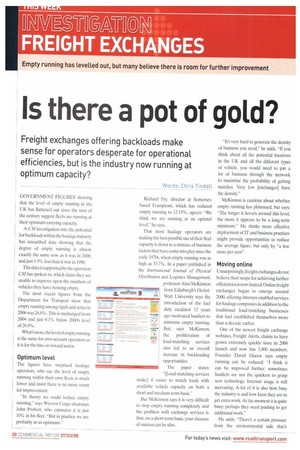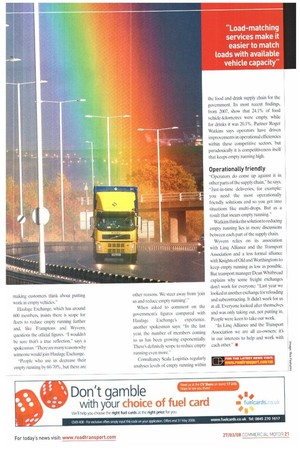Is there a pot of gold?
Page 20

Page 21

If you've noticed an error in this article please click here to report it so we can fix it.
Freight exchanges offering backloads make sense for operators desperate for operational efficiencies, but is the industry now running at optimum capacity?
Words: Chris Tindall GOVERNMENT FIGURES showing that the level of empty running in the UK has flattened out since the turn of the century suggest fleets are running at their optimum carrying capacity.
A CM investigation into the potential for bacldoads within the haulage industry has unearthed data showing that the degree of empty running is almost exactly the same now as it was in 2000, and just 1.9% less than it was in 1996.
This data is supported by the operators CM has spoken to, which claim they are unable to improve upon the numbers of vehicles they have running empty.
The most recent figures from the Department for Transport show that empty running among rigids and artics in 2006 was 26.8%. This is unchanged from 2004 and just 0.1% below 2000's level of 26.9%.
What's more, the level of empty running is the same for own-account operators as it is for the hire-or-reward sector.
Optimum level
The figures have surprised haulage operators, who say the level of empty running within their own fleets is much lower and insist there is no more room for improvement.
"In theory we could reduce empty running," says Wyveni Cargo chairman John Probert, who estimates it is just 10% in his fleet, "But in practice we are probably at an optimum." Richard Fry, director at Somersetbased Framptons, which has reduced empty running to 12-15%, agrees: "We think we are running at an optimal level." he says.
That most haulage operators are making the best possible use of their fleet capacity is down to a mixture of business factors that have come into play since the early 1970s, when empty running was as high as 33.7%. In a paper published in the International Journal of Physical Distribution and Logistics Management, professor Alan McKinnon from Edinburgh's HeriotWatt University says the introduction of the fuel duty escalator 12 years ago motivated hauliers to minimise empty running. But, says McKinnon, the proliferation of load-matching services also led to an overall increase in backloading opportunities.
The paper states: "[Load-matching services makej it easier to match loads with available vehicle capacity on both a short and medium-term basis."
But McKinnon says it is very difficult to stop empty running completely and the problem with exchange services is that, on a short-term basis, your chances of success can be slim. "It's very hard to generate the density of business you need," he adds. -If you think about all the potential locations in the UK and all the different types of vehicle, you would need to put a lot of business through the network to maximise the probability of getting matches. Very few [exchanges] have the density."
McKinnon is cautious about whether empty running has plateaued, hut says: "The longer it hovers around this level, the more it appears to be a long-term minimum." He thinks more effective deployment of IT and business practices might provide opportunities to reduce the average figure, but only by "a few more per cent".
Moving online
U nsurprisingly, freight exchanges do not believe their scope for achieving further efficiencies is now limited. Online freight exchanges began to emerge around 2003, offering internet-enabled services for haulage companies in addition to the traditional load-matching businesses that had established themselves more than a decade earlier.
One of the newest freight exchange websites, Freight Alerts, claims to have grown extremely quickly since its 2006 launch and now has 1,000 members. Founder David Hiscox says empty running can be reduced: "I think it can be improved further; sometimes hauliers are not the quickest to grasp new technology. Internet usage is still increasing. A lot of it is also how busy the industry is and how keen they are to get extra work. At the moment it is quite busy; perhaps they need pushing to get additional work."
He adds: "There's a certain pressure from the environmental side that's making customers think about putting work in empty vehicles."
Haulage Exchange. which has around 600 members, insists there is scope for fleets to reduce empty running further and, like Framptons and Wyvern, questions the official figures.'l wouldn't be sure that's a true reflection," says a spokesman. "There are many reasons why someone would join Haulage Exchange.
-People who use us decrease their empty running by 60-70%. but there are other reasons. We steer away from loin us and reduce empty running'.
When asked to comment on the government's figures compared with Haulage Exchange's experience, another spokesman says: -In the last year, the number of members coming to us has been growing exponentially. There's definitely scope to reduce empty running even more."
Consultancy Scala Logistics regularly analyses levels of empty running within the food and drink supply chain for the government. Its most recent findings, from 2007, show that 24.1% of food vehicle-kilometres were empty, while for drinks it was 20.1%. Partner Roger Watkins says operators have driven improvements in operational efficiencies within these competitive sectors, but paradoxically it is competitiveness itself that keeps empty running high.
Operationally friendly
"Operators do come up against it in other parts of the supply chain," he says. "Just-in-time deliveries, for example: you need the most operationally friendly solutions and so you get into situations like multi-drops. But as a result that incurs empty running."
Watkins thinks the solution to reducing empty running lies in more discussions between each part of the supply chain.
Wyvern relies on its association with Ling Alliance and the Transport Association and a less formal alliance with Knights of Old and Worthingtons to keep empty running as low as possible. But transport manager Dean Whitbread explains why some freight exchanges don't work for everyone: "Last year we looked at another exchange for reloading and subcontracting. It didn't work for us at all. Everyone looked after themselves and was only taking out, not putting in. People were keen to take our work.
-In Ling Alliance and the Transport Association we are all co-owners; it's in our interests to help and work with each other." •




























































































































































